Assaults drive big rise in primary school exclusions
Jess Brown
Thursday, July 30, 2015
The number of primary school children being excluded from school has risen sharply with the increase put down to rising levels of violence and ‘persistent disruptive behaviour'.

Figures published by the Department for Education show that there were 870 permanent exclusions from primary schools in 2013/14, compared with 670 in 2012/13 – an increase of 29.9 per cent.
There was also a marked increase in fixed-period exclusions in primary schools – a form of sanction that can be imposed for a maximum period of 45 days.
In total, there were 45,010 fixed-period exclusions in 2013/14, an 18.9 per cent increase on the 37,870 recorded in 2012/13.
The DfE said the increase was driven by more fixed-period exclusions for assaults against adults, assaults against children and persistent disruptive behaviour.
It said primary school exclusion rates are now at their highest level since 2007/08.
Kevin Courtney, deputy general secretary of the National Union of Teachers, says schools’ ability to manage particularly difficult cases of behaviour has been adversely affected by cuts to local authority budgets, in particular behaviour support services.
“Narrowing the school curriculum, the reduction in creative subjects and the removal of some play times for primary pupils may all be factors affecting behaviour in schools,” he added.
"These issues need to be addressed to ensure that all pupils are given the opportunity to fulfil their potential.”
Mary Bousted, general secretary of the Association of Teachers and Lecturers (ATL), described the figures as “worrying”.
“It is essential we identify the causes of persistent disruptive behaviour, get underneath this label and find ways to support those children and young people," she said.
“Children are most likely to be excluded in Year 5 in primary school or Year 9 and 10 in secondary school.
"What is it about our education system that doesn’t work for the children excluded at these times?
“We know that supporting children at risk of exclusion requires a huge amount of flexibility, expertise and patience, but many of these services have been reduced or cut in recent years.
“Ultimately, this data raises a lot of difficult questions for the government, school leaders, teachers, local authorities and parents, and we must work together to find a way to make our education system work for all our children and young people.”




